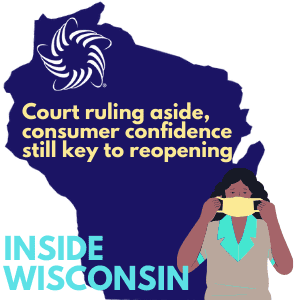By Tom Still
 MADISON, Wis. – The virus that circled the globe in under six months is not going away simply because a divided Wisconsin Supreme Court struck down the state’s “safer at home” order. Everyone understands that dangerous medical reality … or should.
MADISON, Wis. – The virus that circled the globe in under six months is not going away simply because a divided Wisconsin Supreme Court struck down the state’s “safer at home” order. Everyone understands that dangerous medical reality … or should.
Likewise, the economic damage that has ensued since COVID-19 emerged in late fall is also not likely to go away soon, even if some parts of Wisconsin open the doors to businesses faster than others.
The reason for the second point is simple enough: Many people will stay away from bars, restaurants and large gatherings until they feel it’s safe to return.
The question before the Supreme Court was whether state Health Services Secretary Andrea Palm exceeded her authority in issuing the administration’s second emergency order, which was otherwise scheduled to expire May 26. The court’s 4-3 ruling that the order went too far was a legal one, not a referendum on whether COVID-19 had checked out from the planet.
Public-opinion polls, both state and national, suggest that most people have supported such orders, even if that enthusiasm withered as the economic malaise deepened. It leaves both policymakers and ordinary people alike asking how, or if, the risks of a renewed outbreak can be balanced against the possibility of an enduring depression.
Short of an effective vaccine or “herd immunity,” neither of which is on the near-term horizon, what steps might restore confidence to the point that consumers return? Here are some possibilities:
- Consider requiring face masks for indoor, public places, at least for a while. It’s a simple way to protect those who are most vulnerable. With the Memorial Day weekend coming up, perhaps with a flock of out-of-state visitors, that’s not too much to ask for the safety of Wisconsin workers.
- Keep up the “scorecard” approach to providing people with information on key safety metrics, such as positive and negative tests, hospitalization rates and mortality rates.
- Include in that scorecard how Wisconsin fares in some of the more prominent national computer models, such as those constructed by the University of Washington and the University of Texas. Those models crunch real data to make COVID-19 forecasts.
- It should no longer fall to government to decide what businesses are “essential” and which are not, but to assess which businesses follow rigorous safety and sanitation rules and which do not. That’s a matter for public health inspections, a normal duty of government, versus an arbitrary designation of which businesses and jobs matter more than others. If you’re working for a restaurant or retail store and that’s your only source of income, that job is “essential” to you.
- Consider ways to extend “contact testing” without sacrificing privacy. There are private firms in Wisconsin that can help in training, implementation and secure technology.
- Encourage people to go outside … and for businesses to migrate some of their customer-facing activities to the outside, such as outdoor restaurant seating. Medical science has learned a lot since the onset of COVID-19, and one emerging conclusion is that it’s hard to catch the virus while outdoors. One study of 1,245 coronavirus cases across China found that only two came from outdoors transmission. As Dr. Marty Makary of Johns Hopkins University told the New York Times: “The outdoors is not only good for your mental state. It’s also a safer place than indoors.”
Businesses can reopen, but it doesn’t mean people will show up to buy things if they think it’s unsafe to do so. A reasonable measure of confidence will be required first.
Lockdowns in Wisconsin and elsewhere were never sustainable forever, or even for very long. They can be safely lifted, however, if restless consumers regain the confidence to believe it’s safe to venture out again.
Still is president of the Wisconsin Technology Council. He can be reached at tstill@wisconsintechnologycouncil.com.


